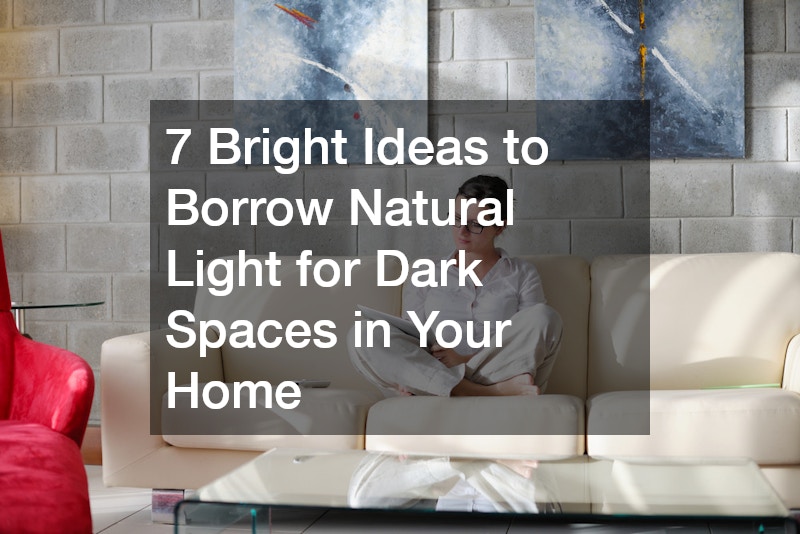Today, many homes are built with limited access to natural light due to confined spaces, orientation challenges, or design constraints. Unfortunately, relying heavily on artificial lighting not only consumes more energy but also impacts the overall ambiance and mood of your living space. However, there are clever ways to “borrow” natural light from the outdoors and bring it into dark areas of your home. By using innovative design techniques and materials, you can maximize sunlight and create brighter, more inviting interiors.
Here are some of the most effective strategies for borrowing natural light and brightening your home.
1. Reflective Walls and Glass Partitions
One of the simplest ways to bring natural light into a dark space is by using reflective walls and glass partitions. Clear glass allows light to pass from one room to another without obstructing the flow of sunlight.
If placed strategically, these glass partitions can transmit a significant amount of light into nearby spaces. When situated above eye level, they maintain privacy while still ensuring light enters and diffuses throughout the room.
Reflective surfaces, such as glossy paint finishes or mirrors, can also amplify natural light. These surfaces bounce light around the room, making it appear brighter and more spacious. Incorporating materials that reflect light is particularly beneficial in rooms with limited windows or access to direct sunlight.
2. Electrochromatic (Smart) Glass
Electrochromatic glass, also known as smart or privacy glass, offers the flexibility to control the amount of light that enters a room. This high-tech glass can switch between transparent and opaque at the touch of a button, allowing you to borrow light when needed and block it when you require privacy. This makes smart glass an ideal solution for rooms where natural light is desirable but visibility needs to be controlled, such as bathrooms or bedrooms.
Its adaptability makes electrochromatic glass a great option for modern homes, where the balance between privacy and daylight is often a challenge.
3. Stairways as Light Conduits
Stairways often occupy central positions in homes and can serve as natural conduits for light from upper levels to lower ones. If positioned correctly, stairways can bring sunlight down into light-starved spaces like basements or ground-floor rooms. Glazing the stairwell or installing a skylight above can significantly increase the amount of light flowing down the stairs.
Pairing a glass balustrade with white walls enhances the reflective power of the light, creating an airy and bright environment. This strategy works particularly well in multi-story homes where lower levels often lack access to exterior windows.
4. Skylights, Light Tubes, and Roof Lanterns
When it comes to borrowing natural light, few solutions are as versatile and effective as skylights, light tubes, and roof lanterns. Skylights provide a direct link to the sky, flooding a room with sunlight even when surrounding areas have minimal windows. They are particularly useful in hallways, narrow spaces, and areas that lack access to exterior walls. Their ability to bathe a room in natural light makes them a transformative option for spaces that feel enclosed or dim.
If installing a traditional skylight isn’t feasible due to structural limitations, light tubes, also known as solar tubes, offer an excellent alternative. These tubes channel daylight through a highly reflective surface and direct it into darker spaces like bathrooms, closets, or corridors where large windows might not be practical. Light tubes are efficient, easy to install, and cost-effective, making them a great option for homes with limited window space.
Another elegant option is the roof lantern—a decorative feature that acts like a mini glass atrium on top of your roof. Roof lanterns are perfect for larger spaces like living rooms or kitchens, where you want both an architectural statement and a flood of natural light. They bring in sunlight from all angles, giving your room a bright and airy feel while adding a touch of sophistication to your home design. For reliable and high-quality options, Brett Martin roof lantern solutions offer excellent designs that enhance both functionality and style.
Together, these options allow you to maximize natural light in your home, regardless of architectural constraints.
5. Maximizing Light in Basements
Basements are notorious for being dark and uninviting due to their underground location and lack of natural light. While it’s challenging to introduce sunlight to these spaces, there are creative solutions. Solar tubes, as mentioned earlier, are one option, but if your budget allows, consider installing glazed sections in the ceiling with reinforced glass. These sections function like an above-ground window, allowing light from the upper levels to filter down into the basement.
Another option is creating a sunken courtyard adjacent to the basement. This not only brings in natural light but also creates an indoor-outdoor connection that blurs the boundary between the two spaces. If designed well, these courtyards can transform a basement into a bright and appealing living area.
6. Courtyards for Interior Lighting
A courtyard isn’t just an attractive outdoor feature; it’s also a fantastic way to borrow light for rooms that would otherwise be dark and enclosed. By surrounding the courtyard with large windows, you can allow sunlight to flood the interior rooms. A sunken courtyard that extends into the basement can provide much-needed light to lower levels, creating an inviting, well-lit space.
Courtyards also offer opportunities to incorporate natural elements like trees or water features, enhancing the tranquility and aesthetics of your home. In addition to bringing in light, courtyards can help improve ventilation and make interior spaces feel more connected to the outdoors.
7. Clerestory Windows
Clerestory windows, which are positioned high above eye level, are a brilliant solution for borrowing light without compromising privacy. These windows allow light to enter at the top of a room, casting it downward and flooding the space with brightness. Because clerestory windows are set high, they don’t interfere with wall space or furniture placement, making them ideal for living rooms, kitchens, and bedrooms.
The positioning of clerestory windows also enhances the illusion of height and space in a room, giving it an open and airy feel. For homes with limited exterior window space, clerestory windows are an excellent way to maximize natural light.
Closing Thoughts
Bringing more natural light into your home not only enhances the aesthetic appeal but also improves your mood, productivity, and overall well-being. Whether you’re working with small, confined spaces or larger rooms that lack direct sunlight, borrowing light using these clever design techniques can make a world of difference. From glass partitions and stairways to skylights and courtyards, these strategies provide practical solutions for transforming dark rooms into bright, welcoming spaces.
So, consider these genius methods for borrowing natural light and turn your home into a sun-filled sanctuary, no matter how limited your windows may be!
.


